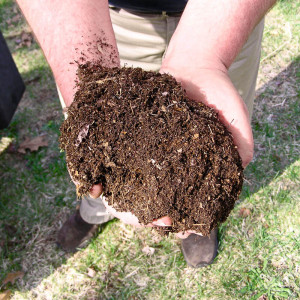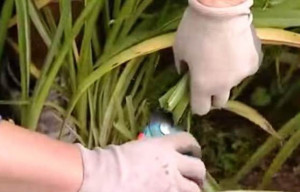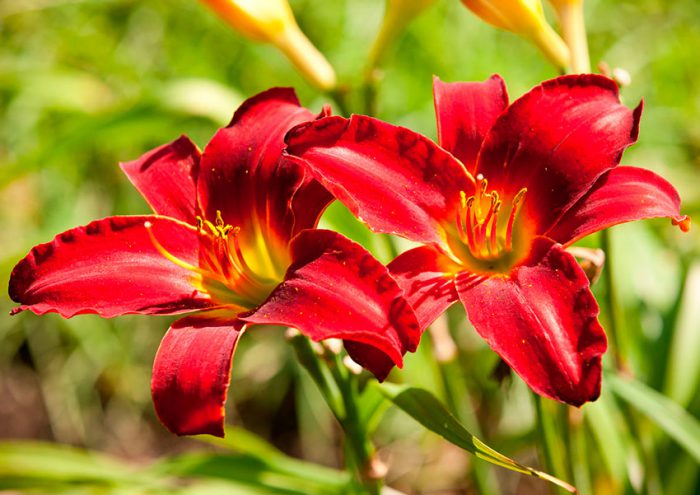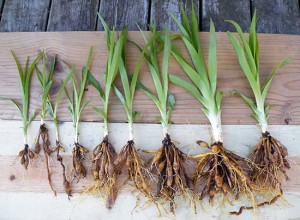Outdoor daylily care
Although it is argued that daylilies do not require special care, it is still worth remembering that most of the hybrid varieties are bred in America, Australia, and France. The climatic conditions of these countries differ from those in Russia. For better adaptation and development of daylilies, it is necessary to create optimal conditions.
Watering flowers
The plant takes root in a new place for 1-1.5 months. The roots, during this period, use more moisture and nutrients not from the environment, but from their own reserves. To exclude stagnation of water, decay of roots, watering should be carried out only after the top layer of the earth dries out.
Adults, flowering plants are watered at the root, abundantly. Moisture on the petals damages the plants. When planting plants in sandy soil, the amount of watering is increased. With a lack of moisture, the leaves turn yellow.
Feeding daylilies

It is necessary to feed daylilies with complex fertilizer
With proper preparation of the seedling and soil for planting, fertilization will not be needed in the first year. The next spring we carry out the first top dressing, preferably with a complex fertilizer, with a lot of nitrogen, for the growth of leaves and peduncles. And phosphorus for better root formation.
In the period of budding and flowering, we add potassium, for a brighter and more lush flowering and resistance to diseases. Daylilies respond well to organic fertilization. Over the years, flower growers specializing in the cultivation of daylilies have developed their own fertilization scheme.
For beginners, lovers of garden flowers, it is advisable to use ready-made complex fertilizers, which are sold in large quantities in specialized stores.
Mulching
When growing daylilies, mulching is widely used to retain moisture in the soil and prepare plants for wintering. In the first case, in the spring, when the soil has warmed up well, after abundant watering, mulch is poured around the plant from rotted humus, bark and needles of (fallen) conifers, and peat.
Mulch serves not only to retain moisture, but also protects the roots from heat, prevents weeds from developing. When distributing the mulch, the root zone is left open. Mulching improves the structure of the soil, enriches it with minerals, and creates a breathable layer. Allows roots to develop better.
In winters with little snow, it will not let the roots freeze. We lay out the mulch after the establishment of cold weather, in late October, early November. We remove in early spring so that the rhizomes do not start to rot.
Pruning daylilies

Whether or not to trim daylilies is a controversial issue.
Whether or not to prune the leaves in the fall is a rhetorical question. Some believe that uncircumcised leaves help the plant during wintering, create additional shelter. Their opponents are categorically in favor of cutting the foliage. This will exclude the possibility of wintering harmful insects in them. If you do decide to trim the leaves, do it as late as possible, and try not to shorten the length by more than two-thirds of the length.
Post-flowering care
The flowering period of daylilies is long and they often fall in bloom under the first snow. If the autumn is long and warm, the plants have time to bloom. The seed pods ripen, the plants prepare for the dormant period. At this time, you can apply granular fertilizer. It is scattered over the surface and shallowly embedded in the ground. Organic fertilizers are also applied before winter. In semi-evergreen species, the dead aerial part is removed. Plants mulch.
Daylily features

The daylily has filamentous, most often thick and fleshy adventitious roots, which are designed to save the plant during dry periods. Broadly linear basal two-row leaf plates can be straight or arcuate curved. Large, six-part flowers, usually funnel-shaped, colored yellow, orange or brownish-red. The inflorescences consist of several flowers. At the same time, no more than three flowers can bloom, the duration of flowering is more than 20 days. On a bush there can be either 1 or several leafy peduncles, the length of which, depending on the variety, can vary from 0.3 to 1 meter (sometimes even higher). The fruit is a triangular box with seeds inside. Gardeners cultivate both natural species and a large number of cultivars and forms.
How to grow and propagate daylilies
Breeding methods for daylilies
Daylilies can be propagated in two ways.
Seeds

Daylilies reproduce both by dividing the bush and by seeds.
The seeds are used only in breeding. There are many reasons for this. Seeds ripen in different varieties from 40 to 80 days. They tie very badly, only with artificial pollination.
Many varieties of daylilies are sterile and never seed. Seeds definitely need stratification. Peduncles with seed pods are cut and placed in water for ripening. They are planted in the soil in autumn or early spring, in grooves no more than 2 cm deep. Seedlings are not transplanted until a normal bush is formed. Flowering occurs in 4-6 years.
By dividing the bush
It is this method that all growers use. How are the timing of the division of the bush determined? If the plant has been in one place for more than five years, the flowering has become less abundant, and the number of peduncles has decreased. The bush has lost its decorative effect and the flowers have become smaller - it's time to start transplanting and reproducing.
In order not to damage the plant, the bush is dug around the perimeter and pulled out with a lump of earth. Then it is immersed in a container with water or the earth is washed out from the roots with a stream of water. The aerial part consists of several fan-shaped rosettes of leaves. With swaying movements, the bush is easily divided into separate parts. If the bush cannot be divided, it is cut. The incision sites are treated to avoid decay. The roots are shortened and the plants are planted in prepared pits.
Planting and leaving
As mentioned above, the daylily planting site should be sunny. For some varieties, you can choose partial shade. Large trees should not be planted near plants. Indeed, in this case, both plants will compete for moisture. It is recommended to plant daylilies from spring to autumn.
The exact time of planting depends on the climate of a particular region. With the imminent onset of winter, a flower planted in the fall does not have time to take root and dies. But if early flowering forms were chosen for planting, then before the onset of frost they will have time to take root and the flower will have time to prepare for wintering. Mulching the beds will also help protect the plant from frost.
Before planting, the daylily must be prepared a little. For this, it is soaked in plain water or diluted mineral fertilizer. At the same time, the roots begin to revive and swell. All resulting roots should be trimmed slightly. Further, it is necessary to dig a hole for each bush, the depth of which is about thirty centimeters.
As for mineral fertilizers, superphosphates or phosphorus-potassium fertilizers can be added to the hole. Daylily roots are placed in the hole and spread over the entire mound without leaving gaps. The hole with the planted flower is sprinkled with earth, and watered abundantly with water. In order to ensure abundant flowering of the daylily, it must be periodically fed with various fertilizers.
The type of fertilizer should be selected based on the condition of the soil.If there is not enough potassium in the ground, then potash fertilizers are chosen, otherwise the leaves of the flower will quickly turn yellow. And phosphorus fertilizers will help the root system of the flower develop quickly. The very first feeding is done after the snow melts. In this case, fertilizers should be complex.
Reproduction and care of krasodnev
Daylily propagation is done in several ways:
- By dividing the root system.
- Growing seedlings.
Dividing a bush is the simplest and most effective breeding method. For such a landing, you must perform the following steps:
As for seed propagation, for this you need to collect seeds in the fall or simply buy them in the store. Plant the seed in the trays at the end of February. When a certain size is reached, the finished seedlings are planted in open ground. If all the recommendations are followed, the newly planted daylily can bloom already this year.
Daylilies are an unpretentious plant that can be planted in any soil. However, for better flowering, you should follow a few very simple rules:
- Choose a place with calcareous soil, it is more suitable for growing this crop.
- It is advisable to choose an open plot with good lighting. This will allow the plant to bloom earlier, throw out larger buds.
- If the summer is very hot, then the daylily is best planted in partial shade.
Krasodnev does not require painstaking care. However, it should be watered regularly, carry out autumn feeding with complex fertilizers.
Subject to all the nuances of planting and care, daylilies are able to live in one place for more than twenty years, without losing their splendor and decorative effect.
Daylily can become a decoration of any garden. It brings joy to the gardener, pleasure to the collector. The flowers of a plant can have different shapes and all sorts of color palettes. The height of the bushes directly depends on the variety. Every year, all new varieties are bred, which makes it possible to replenish the collections in the garden.
‘Strawberry Candy’
This daylily lives up to its fruity name at first glance. This modest variety with a height of just over 70 cm has earned all its medals and insignia not only for its stunning colors, but also for its endurance.
 Daylily, variety 'Strawberry Candy'. Rocky dale
Daylily, variety 'Strawberry Candy'. Rocky dale
Luxurious flowers up to 12 cm in diameter are distinguished by wide, almost round petals and an increased density of their arrangement, a unique color of a rich caramel tone. All petals are adorned with darker, but no less strawberry ruffles and spots that form an almost perfect circle within the flower, emphasizing the shape of the pharynx. The flowers appear vibrant and watercolor-colored, even more formidable thanks to their unusual corrugation.
 Daylily, variety 'Strawberry Candy'. Jeff and Ellen
Daylily, variety 'Strawberry Candy'. Jeff and Ellen
This cultivar blooms tirelessly throughout the summer, entering the garden scene as July approaches. A unique feature of Strawberry Caramel is its ability to bloom again at the very end of the season. But you can enjoy the October flowering of this daylily only in favorable conditions, if the weather permits: in order for the plants to start producing flower stalks again, they need warm and sunny days in September.


